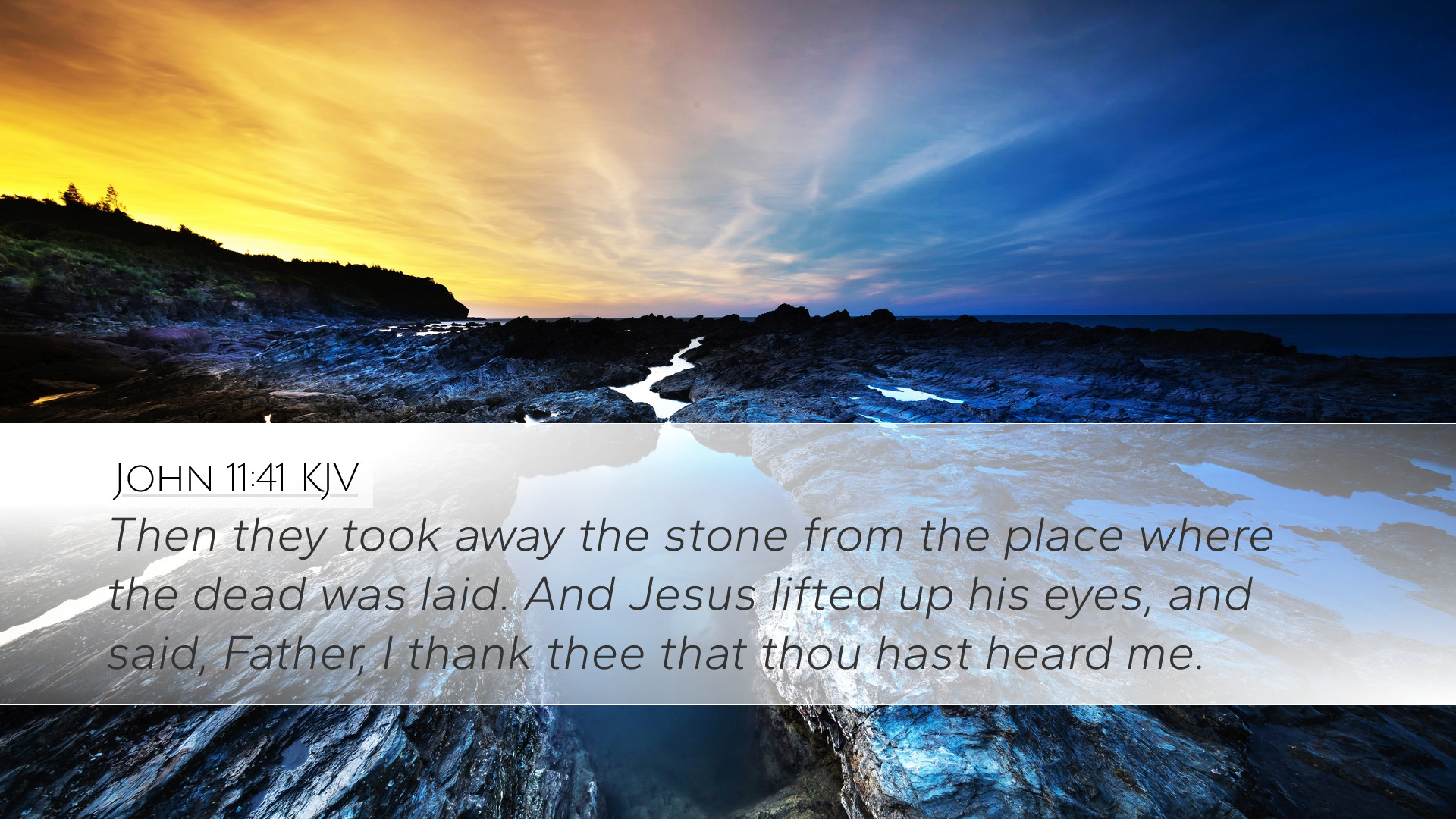Commentary on John 11:41
John 11:41 states, "Then they took away the stone from the place where the dead was laid. And Jesus lifted up his eyes, and said, Father, I thank thee that thou hast heard me." This verse is pivotal in understanding both the context of Jesus' miracle of raising Lazarus and the theological significance of His relationship with the Father.
Contextual Analysis
This moment occurs just before one of Christ’s most profound miracles—the raising of Lazarus, who had been dead for four days. The act of removing the stone was not merely a physical task; it symbolized the removal of barriers between life and death, illustrating the transformative power of Christ.
Insights from Public Domain Commentaries
Matthew Henry's Commentary
Matthew Henry emphasizes several important points in relation to this verse:
- Importance of Prayer: Henry notes that Jesus' prayer before performing the miracle underscores the importance of communion with God. Jesus thanks the Father publicly, showcasing a model of prayer that is both grateful and expectant.
- Expression of Faith: He suggests that Jesus’ act of lifting His eyes toward heaven reflects the deep connection He had with the Father. It illustrates His reliance on divine power, contrasting human limitation.
- Public Acknowledgment: Henry points out the significance of performing the miracle in the presence of others to reinforce faith and reveal the deity of Christ.
Albert Barnes' Notes on the Bible
Albert Barnes provides additional insights that are vital for understanding this passage:
- Thanksgiving in Prayer: Barnes highlights the act of Jesus thanking the Father, which models for believers the necessity of acknowledging God's sovereignty in prayer. It demonstrates a spirit of gratitude before invoking God’s power.
- Affirmation of Faith: In his commentary, Barnes asserts that Jesus’ prayer signifies His confidence that the Father hears and answers prayers, which speaks to the assurance of faith all believers should possess.
- Witness to God’s Glory: Barnes notes that through this miracle, Jesus aims to manifest the glory of God, serving the dual purpose of beckoning faith in the witnesses and reaffirming His identity as the Messiah.
Adam Clarke's Commentary
Adam Clarke offers profound theological reflections concerning John 11:41:
- Theological Implications: Clarke argues that this text portrays the profound relationship between Jesus and the Father, highlighting Christ’s role as mediator who perfectly represents humanity’s need for divine intervention.
- Sovereignty and Human Agency: He discusses the balance of divine sovereignty and human action, noting that while God is sovereign, human participation (like removing the stone) is crucial in the unfolding of God’s plans.
- The Role of Faith: Clarke emphasizes the necessity of faith in the context of miracles, suggesting that Christ's act of prayer prior to the resurrection act serves to strengthen the faith of those present, promoting a deeper understanding of divine capability.
Theological Reflections
From these commentaries, several theological themes emerge which merit deeper reflection:
The Act of Thanksgiving
The act of thanksgiving in Jesus' prayer highlights the essential nature of gratitude in prayer life. It serves as a model for believers to follow, emphasizing a heart posture that recognizes and uplifts God’s influence and benevolence.
The Power of Divine Connection
Jesus’ act of lifting His eyes signifies a deep reliance on the Father. It serves as a reminder to believers of the need for a constant connection with God, especially when confronting situations of despair or hopelessness.
Miracles as a Witness to Faith
This event serves not only as a miracle but also as a demonstration of Jesus’ divine authority. Miracles are not just acts of power; they are revelations designed to nurture faith in those who witness them.
God's Glory Made Manifest
Throughout this passage, God's glory is a central theme, revealing how God’s miraculous actions are intended for the edification of faith and public testimony. Jesus illustrates perfectly that His works are to glorify the Father and lead others to recognize Christ as Lord.
Practical Applications
Reflecting on John 11:41 encourages several practical applications for pastors, students, and scholars:
- Modeling Prayer: Emphasize the importance of prayer in your congregational teachings, showcasing the intercessory role of Christ as a template for believers' prayers.
- Encouraging Faith: Use moments of testimony and discussion about miracles to foster an environment of faith and expectation for the divine work in the lives of the congregation.
- Discussing Divine Sovereignty: Engage with congregants about the profound mystery of God's sovereignty in conjunction with human action, fostering deeper theological discussions.
- Celebrating God’s Glory: Regularly reflect on God's glory in teachings, emphasizing how each act of divine intervention is an opportunity for growth in faith and relationship with God.
Conclusion
John 11:41 plays a significant role in understanding the nature of Christ and His relationship with the Father, situating the miracle within the larger narrative of faith, prayer, and divine glory. By studying this verse through the lenses of biblical scholars and commentators, we gain deeper insight into the life of faith that we are called to live.


